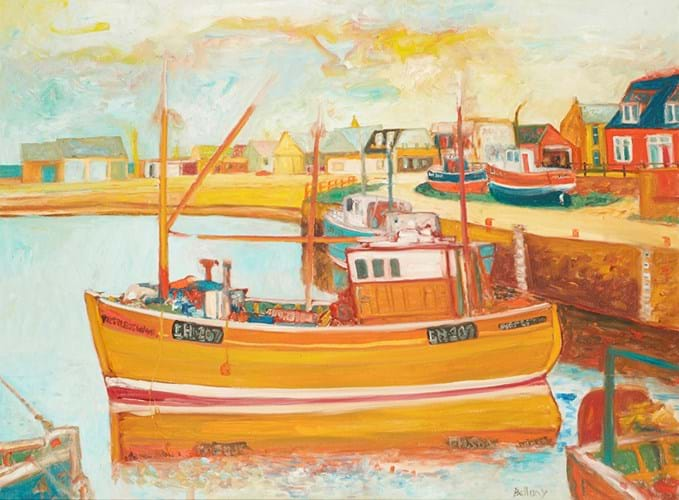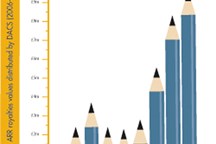
Artist’s Resale Right gives creators of original works across their lifetime, and for 70 years after their death, the right to a payment when their work is resold in the secondary market with the involvement of an art market professional.
The rules, which came into force via an EU directive in 2006 updated in 2011 (see box, below), apply to works sold in the UK or another country in the European Economic Area (EEA) by an artist in the region.
From 1 April 2024, the Artist's Resale Right in the UK became calculated in pounds rather than in euros as was the case previously.
Who pays ARR?
In the UK, it is almost always the buyer who pays the ARR due on any sale. When the regulation came into effect in 2006, the government decided that the seller together with the art market professional involved (the auctioneer, for example) should be liable.
However, auctioneers and dealers have the option in their terms of business to decide whether to charge ARR to either the buyer or seller although, in practice, they tend to charge the buyer.
Other countries in the EU can apply ARR differently.
For example, In Ireland it is the seller, rather than the buyer, who is responsible for paying the ARR levy. For auctions, this can be done by the vendor paying the levy directly to the auction house which will in turn forward it to Ireland’s collecting body The Irish Visual Artists Rights Organisation (IVARO), or by the seller contacting IVARO directly.
Agencies that collect fees in the UK
Two agencies administer the collecting of the artists’ right fee in the UK: the Design and Artists Copyright Society (DACS) and the Artists’ Collecting Society (ACS).
When selling a work that qualifies for ARR, auction houses and dealers have responsibility to pay the correct amount and calculate the correct exchange rate at the time of sale (based on the exchange rate from the European Central Bank on the day of the sale).
Both agencies provide online calculators and checking guides on their websites to assist art market professionals on who to pay and how much. The auctioneer or dealer, who must check which is the relevant agency to pay, will have passed on the cost of this payment to the buyer.
Both ACS and DACS charge a 15% administration fee which is taken from the rights payments they receive. ACS claims its figures “help to dispel the myth that the bulk of all ARR royalties are paid to a small number of renowned artists’ estates”. It argues that any surplus income made from royalty payments is used for “the benefit of member artists and the artistic community”.
The art trade has largely been against ARR and continues to argue it is an unjust tax that disadvantages the UK and European art markets, over those in the US and Asia, and that it predominantly benefits wealthy artists’ estates.
Common misconception
Not everyone in the art market is in agreement, however.
Lawyer Rudy Capildeo at Charles Russell Speechlys acts for a number of artists and artists’ estates. He said: “Resale royalties are an incredibly important source of income for artists and their families. There is a common misconception, however, that this generally applies to blue-chip artists like Picasso and Hirst.
“The reality is that the royalties are often paid to all artists who have maintained a career and whose works still have a market today.
“A key issue for collecting societies is getting private dealers to cooperate so that artists and their heirs receive the royalties that are due to them, a matter made worse by the inherent confidentiality of art world transactions.
“Musicians, authors and filmmakers alike receive royalties. Artists too should be able to share in the benefits that their work brings to others.”
Artist’s Resale Right – the rules
Royalties are paid on original works of art (including graphic works, paintings, sculptures, collages, ceramics and street art) when they are resold by an art market professional and the sale price exceeds £1000.
The amount due is calculated on a sliding scale according to the resale price of the artwork and is capped at £12,500.
- 4% up to £50,000 (previously €50,000 up until 1 April 2024)
- 3% between £50,001-200,000 (previously €50,001-200,000)
- 1% between £200,001-350,000 (previously €200,001-350,000)
- 0.5% between £350,001-500,000 (previously €350,001-500,000)
- 0.25% in excess of £500,000 (previously €500,000)
The scale is also cumulative and so, for example, the royalty payable for an art work sold for £200,000 would amount to £6500.
This is made up of:
- 1st tier to £50,000 will attract a royalty of 4% ie £2000
- 2nd tier £50,001 to £200,000 will attract a royalty of 3% ie £4500
Royalties are calculated on the sale price minus VAT for galleries and the hammer price, (sale price minus VAT and Buyers Premium) for auction houses.
VAT does not apply to the Artist’s Resale Right and resale royalties are calculated on the sale price excluding VAT.
ARR only applies to single items and is not charged on lots with multiple items that make over the £1000 threshold.
The fee does not apply to ‘first sales’ where works are sold for the first time. This includes at auctions, so any lots from a studio sale for example which make over £1000 are exempt from ARR.
The maximum amount an artist or an artist’s estate can receive per sale is £12,500, while a ‘bought as stock’ exemption means if a work of art was acquired directly from the artist and is resold within three years for a sum less than £10,000, the sale does not attract ARR.
The law is derived from a European Directive that came into force in the UK in 2006 and was later updated in The Artist’s Resale Right (Amendment) Regulations 2011 where it was extended to heirs or artists for 70 years after their death.
The artist does not have to be registered to a specific agency, the fee still applies.
While initially the seller was the liable party for the ARR, it is now the buyer who pays the levy in the UK.
For more information see gov.uk/guidance/artists-resale-right

Here is an example of a picture that sold at auction and qualified for ARR. Knocked down at £5500 at Lyon & Turnbull, Edinburgh in August 2019, ‘Restless wave in an east coast harbour’ by John Bellany was subject to an ARR royalty of £220.
What does this mean for buyers?
The fee for Artist’s Resale Right or Droit de Suite applies in the European Economic Area to living artists and artists who have died in the last 70 years (currently artists who died after 1949).
Buyers of art should be aware that they will pay ARR via a charge by the auction house or dealer that will be passed onto the relevant collecting agency.
If buying at auction the additional ARR fee will be applicable on the hammer price if it reaches the threshold of £1000.
If buying from a dealer the buyer should find out if the price quoted includes the fee.
Buyers should also bear in mind that when acquiring an artwork that qualified for ARR the same work may not be subject to that fee when it is later sold on because it may be more than 70 years since the creator’s death.
Sales from artist's estates
How does ARR apply to works being sold fresh to the market directly from an artist’s estate?
For example, when a group of works consigned by LS Lowry’s estate appeared at Christie’s on June 18, 2019 they were marked in the catalogue as subject to ARR, even though they were billed as “a unique opportunity for collectors to acquire works directly from the artist’s ownership, which have been on long-term loan to museums and galleries since the artist’s death”.
So how is it that these works – being sold for the first time – could be subject to resale right?
Both the auction house and the collecting agency DACS confirmed to ATG that auction consignments from artist’s estates attract ARR as they are regarded as ‘resales’ under the regulations.
Section Three of the act states that ARR applies “on any sale of the work which is a resale subsequent to the first transfer of ownership”.
The key wording in the regulations that define the ‘transfer of ownership’ (section 3, paragraph 5) states that it includes “disposal of the work by the author’s personal representatives for the purposes of the administration of his estate”.
Christie’s said: “The transfer of title to the artist’s estate when the artist dies counts as the first transfer of ownership, making the subsequent sale by the estate through Christie’s a ‘resale’ subject to ARR.”
The auction house also confirmed that Lowry’s estate would be the beneficiary of the ARR payments from the recent sale, thereby creating the unusual situation where a UK vendor ends up receiving the ARR payment (minus the collecting agency’s fees).
DACS pointed out that “artists’ estates are extremely diverse, ranging in size, scale and resources”. It added: “They are not always the recipient of the Resale Royalties, as artists may decide to divide Rights among different family members or friends when they write their wills.”
In Ireland however, when it comes to artists’ estates selling works, these transactions are considered to be ‘sales’ in Ireland rather than ‘resales’, and so no fee is sought in these instances. This therefore avoids the potentially curious situation in which an artist’s estate, where it is also the rightful beneficiary of ARR, would have had to pay the ARR levy to itself.
ARR Collecting Agencies
Design and Artists Copyright Society (DACS)
- 100,000 artists and artists’ estates represented
Artists Collecting Society (ACS)
artistscollectingsociety.org.uk
- 1342 mainly UK artists and artists’ estates represented




